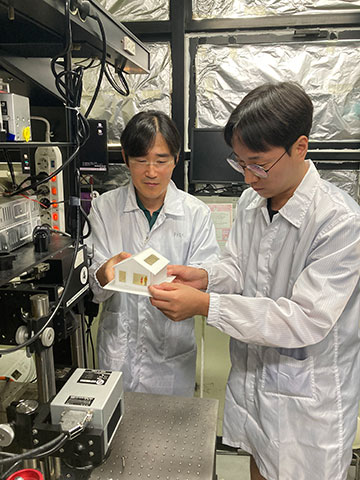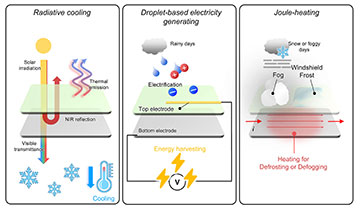
Seoul National University researchers Seung Hwan Ko (left) and Yeongju Jung study a model of a home with a multifunctional smart window. [Image: Seoul National University College of Engineering]
Could a transparent window cool a building’s interior, generate electricity on rainy days and keep itself free of frost and fog? Researchers at a university in the Republic of Korea have invented a prototype window that performs all three actions.
The all-in-one “smart window” consists of layers of a fluorine-containing copolymer, silver and a conducting oxide (Nano Energy, doi: 10.1016/j.nanoen.2024.110004). The compound window material reflects near-infrared rays back outdoors to cool an enclosed interior space by an average of 5.2°C while producing electrical current from an unusual source: falling water droplets.
A multifunctional sandwich
In recent years, scientists have explored many substances that could act as transparent radiative coolers, so that windows in a building can cool rooms without using electrically powered air conditioning. Such cooling panes need to selectively block the longer-wavelength rays from sunlight while letting most of the visible spectrum pass through. It also helps if the window material can radiate thermal energy outward from the building.
The team at Seoul National University fabricated its smart window from a sandwich of 250-μm-thick fluorinated ethylene propylene (FEP) film, which provides the radiative cooling of 8- to 13-μm wavelengths, indium tin oxide (ITO) and silver. The latter two, totaling only 90 nm thick, reflect NIR light and collect the charges as a “droplet-based electricity generator,” or DEG.
Making electricity from raindrops falling on a window might sound unusual, but it’s an example of the triboelectric effect; scientists such as Lord Kelvin and Philipp Lenard investigated water droplets’ ability to generate static electricity in the late 19th century. The amount of power that the team made from water droplets―approximately 8.3 W/m2―is enough to light up an LED, says researcher Seung Hwan Ko. Since rain is inherently intermittent, however, the window would need to be attached to a battery or supercapacitor to store the triboelectric energy.

The main functions of the multifunctional smart window. [Image: © Seoul National University College of Engineering]
Defrosting and defogging, too
With an input of electricity, the multifunctional window could use Joule heating to clear itself of frost or fogging. The researchers tested this out by measuring the transmittance and scattering of a visible laser beam with the heating turned off and on.
According to Ko, most recent studies of DEG and transparent radiative cooling have employed separate components for the two functions. The Seoul National group, however, combined them, plus defogging, in a single windowpane structure.
The multifunctional window demonstrated a transmittance of 0.652 at visible wavelengths, a reflectance of 0.474 of near-infrared rays and an emittance of 0.972 at thermal wavelengths. The layered material is flexible enough to incorporate into curved window designs.
“In this study, we focused on lab-scale fabrication,” Ko says. “To advance this work toward practical applications, we plan to conduct further experiments aimed at large-scale production and improving transparency in the visible light spectrum. If successful, these advancements could enable direct application in homes, office buildings and vehicles, potentially contributing to the development of next-generation electric vehicle technology.”
